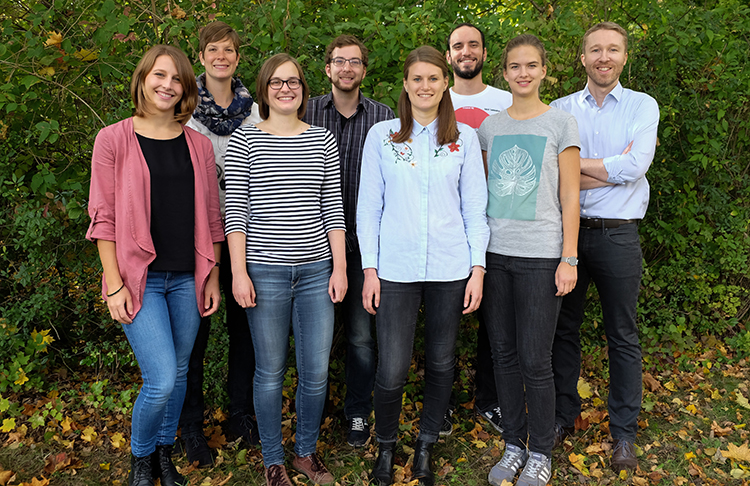
At the forefront of material development, Dr Peter Wich is developing unique materials for future nanomedicine applications in drug delivery and personalised medicine.
Dr Peter Wich relocated his lab to UNSW from the University of Mainz in Germany in 2018 because he saw multiple synergies between their research focus and the activities underway in the disciplines of chemical engineering, materials science, bioorganic chemistry and nanomedicine across the University.
Now he is based as a sub-team within the Centre for Advanced Macromolecular Design in the School of Chemical Engineering and the Australian Centre for NanoMedicine. Wich says his lab is predominantly a chemistry and biopolymer-based research group focused on material development.
“We don’t synthesise traditional polymers, but rather learn from some of nature’s best examples, like protein complexes, enzymes and virus particles, in order to produce bio-inspired, bio-mimetic materials,” he explains.
Using natural materials, mainly polysaccharides and proteins, Wich’s team undertakes mild chemical modifications of these biopolymers to create biohybrid materials. These have new chemical and functional properties, are more dynamic and can be linked with synthetic polymers to extend and in some cases completely change the underlying function they already had.
“The idea is to create biomaterials with either improved, or in some cases completely new functions. For example, we are looking at using nanoparticles, functional assemblies and artificial enzymes that can not only mimic cellular function but also perform completely new and, so far, unknown reactions,” he says.
Wich says nature is his primary inspiration because of its astounding array of materials and highly functional molecular machines. “We are still a long way from being as good or efficient as nature, but we have the toolkit of bioorganic chemistry, which we can use to easily modify the biopolymers and change their properties.”
This type of biomimicry is a great starting platform because there are plenty of examples of natural processes which could be harnessed to do useful jobs in humans. For example, mimicking the functions of a virus particle is ideal for developing “nano-pills” to deliver drugs.
“Nature has done a tremendous job of producing proteins that can assemble into a virus, efficiently enter a cell and release the payload it’s transporting. Viruses can even replicate inside a cell, go out and infect new host cells,” Wich continues.
“We don’t yet have the same level of efficiency as a virus, but we are getting close by mimicking some of the virus’ incredible strategies. By using alternative biomaterials, we have the benefit of precise control and the possibility to fine-tune for a specific application or disease.”
Although it is possible to use empty virus shells, inorganic materials or fully synthetic polymers to do this kind of job, Wich says there are concerns about toxicity and the long-term health effects of using some of these materials.
“Even though we are creating something that is not, strictly speaking, ‘natural’ in our labs, we are using materials that have intrinsic, underlying biodegradability and biocompatibility. This is particularly important for nanomedicine applications. And since our materials are so close to what nature is providing, they are well tolerated by the body and show only minimal to no negative side-effects.”
According to Wich, his team are currently working on two main research streams. The first is working with polysaccharides to form nanoparticles that allow the encapsulation of a range of different types of hydrophilic and hydrophobic drugs, genetic material and other proteins.
“We synthesise and modify the sugar-based material, then encapsulate the drugs and analyse the resulting drug delivery system. We further fine-tune the particle size and release properties, and finally hand over the particles to our collaboration partners, for example UNSW Medicine, for further testing.”
In the second project area, the team is developing a completely new class of nanoparticles system based on proteins and enzymes. “We are chemically modifying the proteins to switch their solubility, and then using a biotechnology process to form nanoparticles,” Wich explains.
The big advantage is that, since the chemical modifications are so mild, the underlying protein material of these nanoparticles will not be harmed. The essential proteins and enzymes are still intact and active, resulting in a 2-in-1 system that is able to both deliver drugs and form nano assemblies of functional enzymes that can modify disease-related pathways.
The big picture of this research is to contribute to a future where personalised medicine applications are a standard. “Let’s say you have a specific type of cancer or a special genetic disorder. I envisage a future where your disease will be identified, and a drug produced specially for you. We won’t design the drug itself, but we will develop the nanoparticle systems that can deliver the drug exactly where it is needed,” he explains.
But for now, the main goal is to settle into the Australian research community, build up strong interdisciplinary collaborations, and continue extending the functionality of their ground-breaking bio-inspired materials. As this is a relatively new discipline in the Australian research context, it will certainly be an interesting space to watch.
More information
The Research Lab for Functional Biopolymers, also known as WichLab, is looking for enthusiastic and dedicated new team members. Interested undergraduate and graduate students in the fields of (bio)organic chemistry, chemical engineering, material science, nanotechnology, and neighbouring fields are welcome to get in touch. Visit www.wichlab.com/join for more details.
